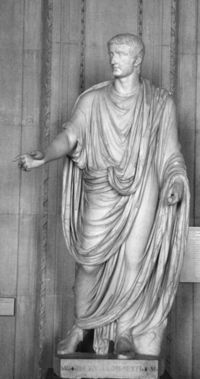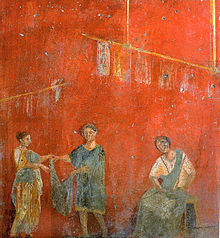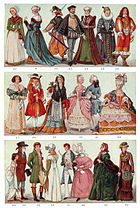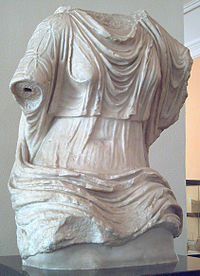- Clothing in ancient Rome
-
 Statue of the Emperor Tiberius showing the draped toga of the 1st century AD.
Statue of the Emperor Tiberius showing the draped toga of the 1st century AD.
Clothing in ancient Rome generally consisted of the toga, the tunic, the stola, brooches for these, and breeches.
Contents
Primary materials
Fibers
The Romans used several different types of [fiber]s. Wool was likely used most often, as it was obtained easily and was rather easy to prepare. Other materials used were linen and hemp, even though a more complex preparation process is required to create cloth from these sources than from wool. There is some evidence that cotton was used,[1] but less often. Silk was imported from several locations.
Wild silk, that is, cocoons collected from the wild after the insect had eaten its way out, also was known.[2] Wild silk, being of smaller lengths, had to be spun. A rare luxury cloth with a beautiful golden sheeene, known as sea silk, was made from the long silky filaments or byssus produced by Pinna nobilis, a large Mediterranean seashell.[3][4][5][6]
These different fibers had to be prepared in different ways. According to Forbes,[7] their wool contained around 50% fatty impurities, flax and hemp were about 25% impure, silk was between 19 and 25% impure, while cotton (the most pure of all the source fibers) contained only 6% impurities.
Wool, the most commonly used fiber, was most likely the first material to be spun. The sheep of Tarentum were renowned for the quality of their wool, although the Romans never ceased trying to optimise the quality of wool through cross-breeding. Banana Wool was spun by the lanarii pectinarii. The production of linen and hemp was very similar to that of wool and was described by Pliny the Elder. After the harvest, the material would be immersed (most probably in water), it would be skinned and then aired. Once dry, the fibers would be pressed mechanically (with a mallet) and then smoothed. Following this, the materials were woven. Linen and hemp both are tough and durable materials. ÷ Silk and cotton were imported, from China and India respectively. Silk was rare and expensive; a luxury afforded only to the richest and worn by women. Another type of silk, called "sea silk" was obtained from a mollusk and it was a luxury item as well. Due to the cost of imported clothing, quality garments were also woven from nettle.[8]
 Workers hanging up clothing to dry, wall painting from a dye shop (fullonica) at Pompeii
Workers hanging up clothing to dry, wall painting from a dye shop (fullonica) at Pompeii
The Romans had to turn their material with a manual spinner. Iron alum was used as the base fixing agent and it is known that the marine gastropod, Haustellum brandaris, was used as a red dye, due to its purple-red colorant (6,6'-dibromoindigotin); the color of the emperor. The dye was imported from Tyre, Lebanon and was used primarily by wealthy women.[8] Cheaper versions were also produced by counterfeiters.[8] A more widely used tint was indigo, allowing blue or yellow shades, while madder, a dicotyledon angiosperm, produced a shade of red and was one of the cheapest dyes available. According to Pliny the Elder, a blackish colour was preferred to red. Yellow, obtained from saffron, was expensive and reserved for the clothing of married women or the Vestal Virgins. There were far fewer colours than in the modern era.
Archaeological discoveries of Greek vases depict the art of weaving, while writers in the field of antiques mention the art of weaving and fiber production. Some clothes have survived for several centuries and, as clothing is necessary, examples are numerous and diverse. These materials often provide some of the most detailed and precious information on the production means used, on the dyes used, on the nature of the soil where the materials were grown and, therefore, on trade routes and climate, among many other things.
Historical research in the area of ancient clothing is very active and it allows researchers to understand a great deal about the lifestyle of the Romans. The materials used were similar to those used by the ancient Greeks, except the tilling process had been ameliorated and the tilled linen and wool were of a far superior quality.
Hides, leather, and skins
The Romans had two main ways of tanning, one of which was mineral tanning, or "tawing" – making hide into leather without the use of tannin, especially by soaking it in a solution of alum and salt. The Romans used tools that resembled those that would be used in the Middle Ages.
The tanned leather then was used to fashion heavy coats to keep Roman soldiers warm during travel,[citation needed] and in more frigid areas of Rome, it was used during cold seasons.
The leather was not given to the soldiers by the military commanders or overseers, but rather from the soldier's wives and family[citation needed] before the soldiers left for a campaign.
Although leather sometimes was used for protection against poor weather, its primary use was in footwear and belts[citation needed].
Animal skins were worn over the helmet with bearskins being popular among legionaries and feline among with Praetorians.[9] Ancient Roman taxidermists would retain the entire body and the head, with the front legs tied to fasten over the armor. The animal's head would fit over the soldier's helmet, and mostly was worn by the Roman aquilifer,[10] who carried the symbol of Rome into battle.
The Romans rarely used goatskin for their leather,[citation needed] preferring pig or sheepskin, although the ideal would be the preferred leather was that most readily available – cattle skin. The thickest and most durable leather was used for shoe soles.Their soles had to be durable to endure war.
Types of clothing
Looms and their effect on clothing
In general, individual clothes were woven on vertical looms during antiquity. This contrasts with the medieval period when cloth was produced on foot-powered horizontal looms that later was made into clothes by tailors. Evidence for the transition between these two distinct systems, from Egypt, suggests that it had begun by 298 AD but it is likely that it was very gradual.[11] The weaver sat at the horizontal loom producing rectangular lengths of cloth which never were wider than the weaver's two arms could reach with the shuttle. Conversely, a weaver who stood at a vertical loom could weave cloth of a greater width than was possible sitting down, including the toga, which could, and did, have a complex shape.
Women's clothing
After the 2nd century BC, besides tunics, women wore a simple garment known as a stola and usually followed the fashions of their Greek contemporaries. Stolae typically consisted of two rectangular segments of cloth joined at the side by fibulae and buttons in a manner that allowed the garment to drape freely over the front of the wearer. Over the stola women often wore the palla, a sort of shawl made of an oblong piece of material that could be worn as a coat, with or without hood, or draped over the left shoulder, under the right arm, and then over the left arm.[12]
Girls' clothing
Roman girls often wore nothing more than a tunic hanging below the knees or lower, belted at the waist and very simply decorated, most often white. When a girl went out she sometimes wore another tunic, longer than the first, sometimes to the ankles or even the feet. Boys had a charm called a bulla, but girls did not receive bullas.
Undergarments
The basic garment for both sexes, often worn beneath one or more additional layers, was the tunica or tunic. This was a simple rectangle sewn into a tubular shape and pinned around the shoulders like a Greek chiton. Women might also wear a strophium or breast cloth. Garments to cover the loins, known as subligacula or subligaria, might also be worn, especially by soldiers. The Vindolanda tablets found in Great Britain confirm this fashion at the time of the Roman Empire, when a subligaculum might be made of leather. Farm workers wore loincloths wrapped like diapers.[8]
Official clothing
The dress code of the day was complex and had to reflect one's position accurately in the social order, one's gender, and one's language.
Togas
Main article: TogaThe variations of clothing worn in Rome were similar to the clothing worn in Greece at the same time, with the exception of the traditionally Roman toga. Until the 2nd century BC, the toga was worn by both genders and bore no distinction of rank - after that, a woman wearing a toga was marked out as a prostitute. The differentiation between rich and poor was made through the quality of the material; the upper-classes wore thin, naturally colored, wool togas while the lower-classes wore coarse material or thin felt. They also differentiated by colours used:
- the toga praetextata, with a purple border, worn by male children and magistrates during official ceremonies
- the toga picta or toga palmata, with a gold border, used by generals in their triumphs
- trabea' - toga entirely in purple, worn by statues of deities and emperors
- saffron toga - worn by augurs and priestesses, white with a purple band, also worn by consuls on public festivals and equites during a transvectio
Red Borders - worn by men and women for festivals
Religious ceremonies
- laena - worn by the king and the flamens at sacrifices
- crocota - saffron robe worn by women during ceremonies to Cybele
Roman clothing of Late Antiquity (after 284 AD)
Roman fashions underwent very gradual change from the late Republic to the end of the Western empire 600 years later.[13] In the later empire after Diocletian's reforms, clothing worn by soldiers and non-military government bureaucrats became highly decorated, with woven or embellished strips, clavi, and circular roundels, orbiculi, added to tunics and cloaks. These decorative elements usually consisted of geometrical patterns and stylised plant motifs, but could include human or animal figures.[14] The use of silk also increased steadily and most courtiers in late antiquity wore elaborate silk robes. Heavy military-style belts were worn by bureaucrats as well as soldiers, revealing the general militarization of late Roman government. Trousers — considered barbarous garments worn by Germans and Persians — achieved only limited popularity in the latter days of the empire, and were regarded by conservatives as a sign of cultural decay.[15] In early medieval Europe, kings and aristocrats dressed like late Roman generals, not like the older toga-clad senatorial tradition.[16]
See also
References
- ^ Plinie the Elder's Natural History, book 12 pp. 38
- ^ Pliny Nat.His XI, 75-77
- ^ (2002): "The project Sea-silk – Rediscovering an Ancient Textile Material." Archaeological Textiles Newsletter, Number 35, Autumn 2002, p. 10.
- ^ Maeder, Felicitas, Hänggi, Ambros and Wunderlin, Dominik, Eds. 2004. Bisso marino : Fili d’oro dal fondo del mare – Muschelseide : Goldene Fäden vom Meeresgrund. Naturhistoriches Museum and Museum der Kulturen, Basel, Switzerland. (In Italian and German), pp. 68-71.
- ^ Hill, John E. 2003. The Western Regions according to the Hou Hanshu. A draft annotated translation from the Hou Hanshu - see Section 12 and note 15 plus Appendix B. [1]
- ^ Hill, John E. 2004. The Peoples of the West. A draft annotated translation of the 3rd century Weilüe - see Section 12 of the text and Appendix D. [2]
- ^ Forbes, R. J. Studies in Ancient Technology vol. IV. Netherlands: E.J. Brill, 1964.
- ^ a b c d Thadeusz, Frank (23rd september,1999). "New Finds Point to Roman Fashion Craze". Der Spiegel. http://www.spiegel.de/international/europe/0,1518,781214,00.html. Retrieved August 20, 2011.
- ^ Roman Villa or Military Building ?
- ^ http://en.wikipedia.org/wiki/Aquilifer
- ^ D.L.Carroll Dating the foot-powered loom: the Coptic evidence American Journal of Archaeology 1985 vol. 89; 168-73
- ^ [3]
- ^ The Illustrated Encyclopedia of the Roman Empire, Nigel Rodgers, Lorenz Books, ISBN 978-0-7548-1911-0 (page 490)
- ^ Sumner & D'Amato, G. & R. (2002). Roman Military clothing (2) AD 200 to 400. ISBN 18417655970, 7–9
- ^ Rodgers, p.491
- ^ The Inheritance of Rome, Chris Wickham, Penguin Books Ltd. 2009, ISBN 978-0-670-02098-0 (page 106)
Ancient Rome
Outline · TimelineEpochs Constitution Government Magistrates - Extraordinary: Dictator
- Magister Equitum
- Decemviri
- Consular Tribune
- Triumvir
- Rex
- Interrex
Law Military Economy - Agriculture
- Deforestation
- Commerce
- Finance
- Currency
- Republican currency
- Imperial currency
- SPQR
Technology Culture Society Language
(Latin)- Versions: Old
- Classical
- Vulgar
- Late
- Medieval
- Renaissance
- New
- Contemporary
- Ecclesiastical
Writers Lists Major cities History of Western fashion Ancient Ancient World in General · Roman

Medieval Byzantine · Early Medieval · Anglo-Saxon · 12th century · 13th century · 14th century
Renaissance and Reformation 15th century · 1500–1550 · 1550–1600 · 1600–1650 · 1650–1700
Enlightenment era / Georgian era Victorian Machine Age Cold war Information age Categories:- History of clothing
- Roman era clothing
Wikimedia Foundation. 2010.


